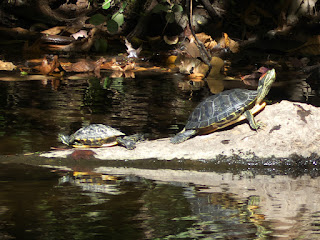Red-eared Slider
Let's show another commonly seen turtle around here: the Red-eared Slider. Most of the time this "species" can be reliably identified by ... (wait for it) ... their red "ear". Why the quotes? First, the Red-eared Slider isn't a species in its own right but is a subspecies of the Pond Slider. Second, the Pond Sliders don't have external ears, red or any other color, though the red mark is about where you'd expect an ear to be if they had external ears. There is another Pond Slider subspecies, the Yellow-bellied Slider, that I'm told is in NJ too, though I can't authoritatively say I've seen one.
These turtles are popular as pets, and pets that have escaped or been released are the main reason the Red-eared Slider is an invasive animal in many parts of the US and other parts of the world. Their popularity peaked when it was revealed that the Teenage Mutant Ninja Turtles were Red-eared Sliders.
As an invasive species they potentially impact their new environment in many ways:
- They may not be recognized as a threat by native tadpoles, driving down amphibian populations as the tadpoles get eaten.
- They may aggressively bully native turtles for resources.
- They may breed faster, supplanting native turtles.
- They may interbreed with other turtles, eventually absorbing these species into their own. There's some evidence they can interbreed with cooters, though it's unclear this happens often enough to matter.
- They can bring diseases with them that native turtles haven't experienced, and which are more serious in the native turtles.
 |
| October 20, 2021 at Duke Island Park Photo 168430821, (c) jpviolette, some rights reserved (CC BY-NC) |



Comments
Post a Comment